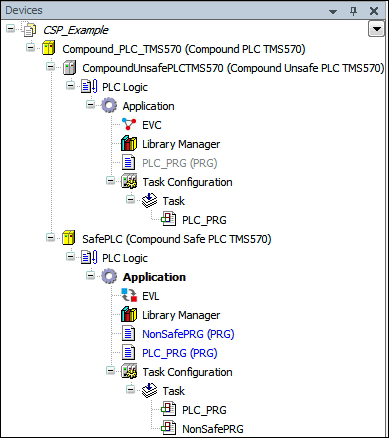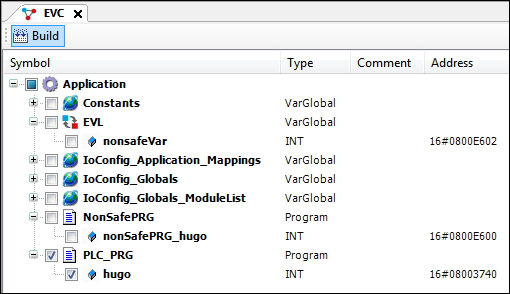Handling of EVC/EVL
Using EVC/EVL in a Compound Safety PLC
EVC (Exchange Variable Connection) can be used within one or more nonsafe subdevices in order to access (safe and nonsafe) variables of the safety subdevice.

Adding EVC to a nonsafe subdevice
You can add EVC (Exchange Variable Connection) to an application like other "POU" objects: Use the Add Object command and dialog and select EVC.
Tip
The name of an EVC object cannot be changed. There can only be one EVC object within an application.
EVC editor
When you open the EVC object, you get the EVC editor. There you configure which variables of the application of the safe subdevice should be available within the application, to which the EVC object belongs.

If the application of the safe subdevice is not up-to-date (if the application was changed after the last successful code generation), then the EVC editor displays a warning similar to the following: Safe application has changed or is not up to date. Execute "Build" command to be able to select variables.
If you want to generate code for the safe application directly, then you can use the Build button. Afterwards, the warning should disappear.
All variables found within the safety application of the safety subdevice are displayed in the EVC editor in a structured way. If you want to access any of these variables individually, then click the corresponding check box. Selected variables are accessible. To remove access privileges to a variable, you clear the corresponding check box.
You can access all accessible variables within the application (where the EVC is located) by means of the namespace "EVC".
IF NOT EVC.GUIDS.xError AND EVC.GUIDS.xGuidValid THEN EVC.EVL.nonsafeVAr := 1; iVar := EVC.PLC_PRG.iVar; END_IF
To check the status of EVC, you should use the implicit member GUIDS of the EVC Namespace in your application. The implicit GVL EVC.GUIDS provides two status variables. As a result, you can monitor the consistency of the EVC variables used.
There are currently two members that you should check to make sure that the mechanism is working correctly:
EVC.GUIDS.xErrorTRUEwhen an error has occurred within the EVC mechanismIn this case, stop accessing the variables which are provided/published by the EVC mechanism. You could crash the safety application.
FALSEwhen the mechanism is working correctly and no error has occurredYou can access the variables which are published within the EVC namespace.
\\ EVC.GUIDS.xGuidValidShows whether or not the safe application, to which the EVC is connected, is exactly the same one as configured in the project (matching GUIDs)
If this variable is
FALSE, then stop accessing the variables which are provided/published by the EVC mechanism. You could crash the safety application.
Important
You should access variables within the EVC namespace only when xError = FALSE and xGuidValid = TRUE. Otherwise, the safety function of the safety application in the safe subdevice could be affected.